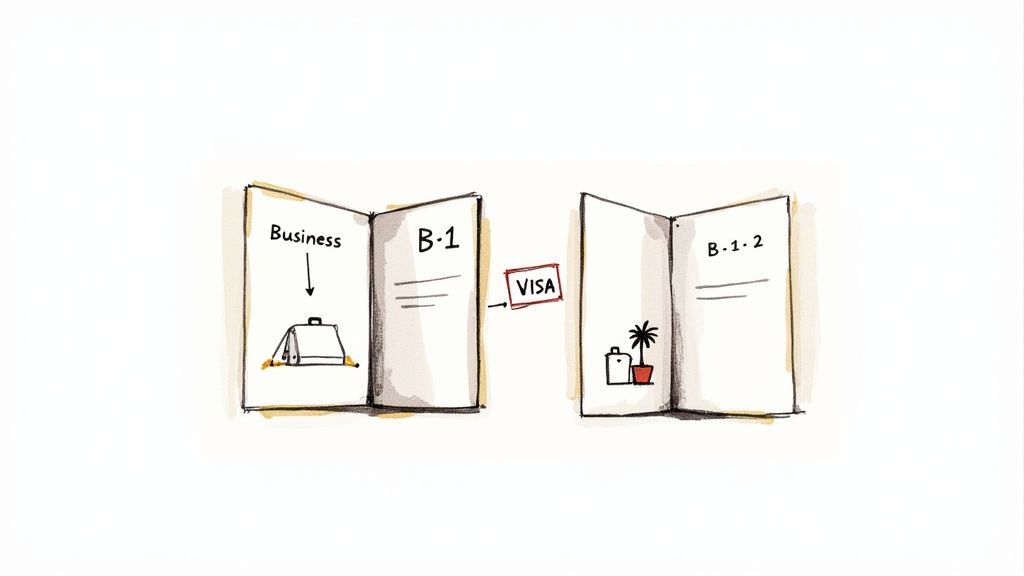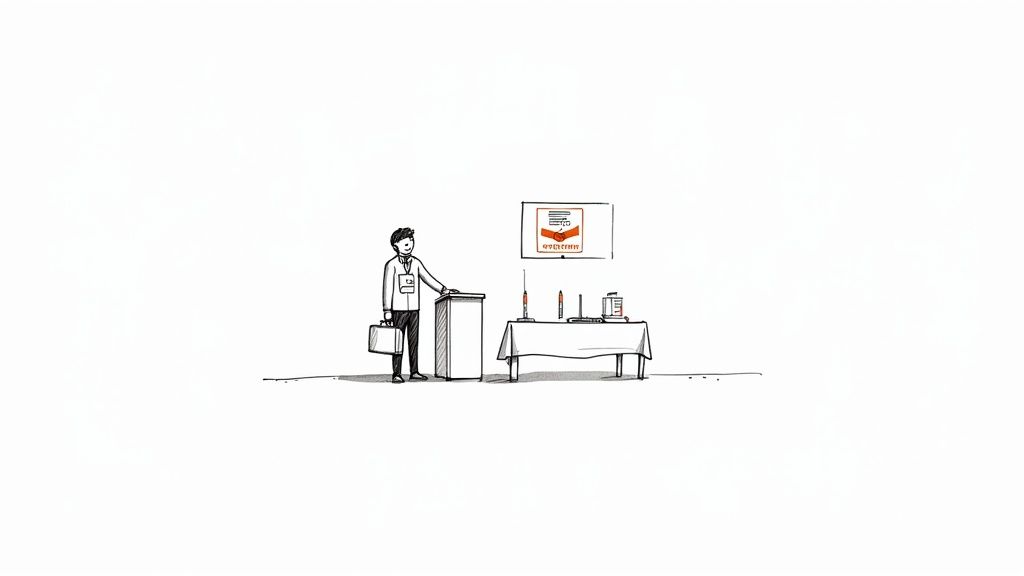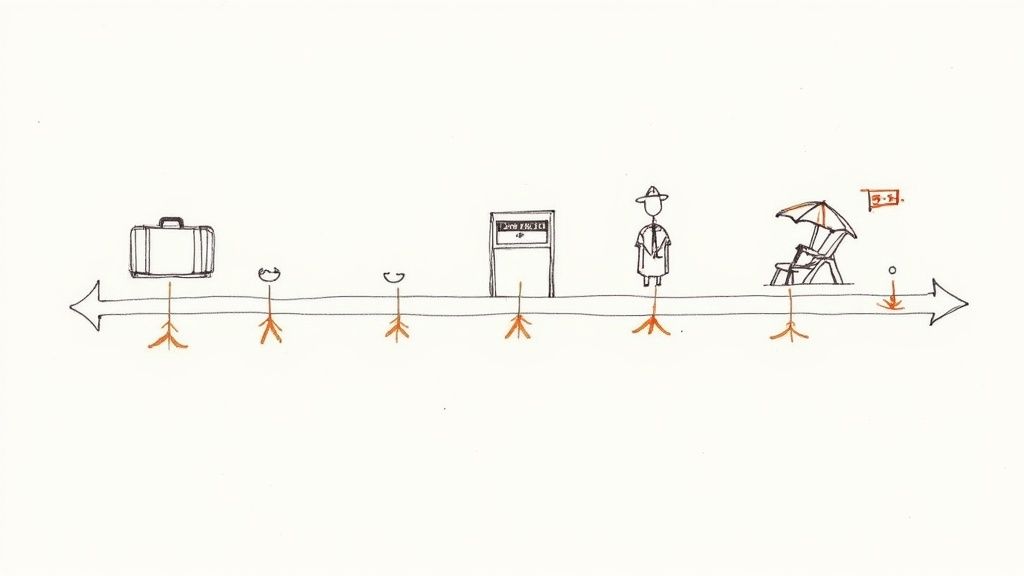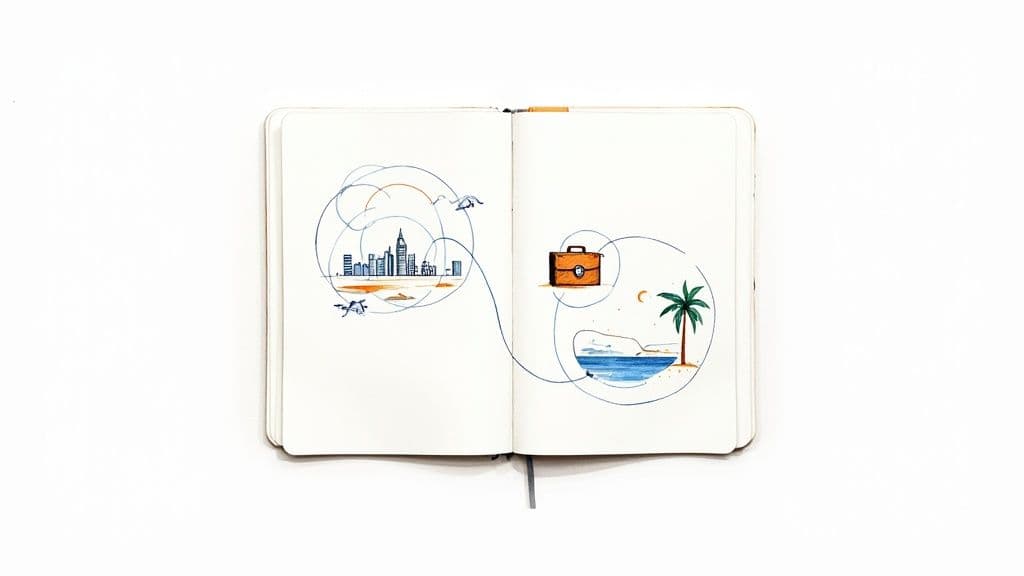The main distinction between a B1 and a B2 visa really boils down to your reason for traveling. The B1 visa is strictly for temporary business-related activities, whereas the B2 visa is meant for tourism, leisure, or medical visits. It's a common point of confusion for applicants, but the good news is that U.S. consulates often issue a combined B-1/B-2 visa, giving travelers a bit more flexibility.
Understanding B1 vs B2 Visa A Quick Overview
Diving into U.S. visa categories can feel overwhelming, especially when you're applying from places like Colombia or Mexico, or even as a third-country national, like an Indian citizen applying from Canada. While both the B-1 and B-2 are nonimmigrant visas for short stays, they authorize completely different activities once you’re on U.S. soil.
Think of the B-1 visa as your ticket for professional trips. This covers things like attending a conference, hammering out a contract, or meeting with business partners. The B-2 visa, on the other hand, is for your personal time—sightseeing, visiting family, or even getting short-term medical treatment.
Because travel plans aren't always set in stone, the U.S. Department of State frequently issues a combined B-1/B-2 visa. This single stamp in your passport means you can travel for either business or pleasure without jumping through hoops for two separate applications. If you're curious about issuance trends, you can find more official U.S. visa data to see the bigger picture.
This simple breakdown helps visualize how the purpose of your trip dictates the right visa category.

As you can see, the fundamental split is clear: if professional goals are the primary driver of your trip, you’re in the B1 lane. If it's all about leisure or personal matters, the B2 is your route.
B1 vs B2 Visa At a Glance
To cut through the noise, this table lays out the core differences between the B1 and B2 visas at a high level. It's a quick reference to help you pinpoint which category aligns with your travel plans.
| Feature | B1 (Business) Visa | B2 (Tourism & Pleasure) Visa |
|---|---|---|
| Primary Purpose | Legitimate business activities | Tourism, pleasure, or visiting family/friends |
| Permitted Activities | Attending conferences, negotiating contracts, consulting with associates | Sightseeing, vacation, social events, short medical treatment |
| Key Limitation | Cannot receive a salary from a U.S. source or engage in local employment | Cannot engage in any form of employment or formal academic study |
| Typical Evidence | Invitation letter from a U.S. company, conference registration | Hotel bookings, travel itinerary, proof of ties to home country |
Ultimately, having the right documents to back up your stated purpose is what matters most to the consular officer. Whether it's a conference registration for a B1 or a detailed travel plan for a B2, your evidence needs to tell a clear and consistent story.
When to Use the B1 Business Visitor Visa
The B1 Business Visitor Visa is your ticket for short-term business activities in the United States. It's specifically for professionals and entrepreneurs from countries like Brazil, South Africa, or Mexico who need to be on the ground for specific commercial purposes.
The most critical thing to understand is this: the B1 visa strictly prohibits you from earning a salary from a U.S. source or engaging in local employment. Think of it as a tool to facilitate international business, not to find a job in the States. Getting this distinction right is everything. If your trip is about meetings, consultations, or negotiations for your foreign-based company, you're on the right track.

Permitted Business Activities
So, what can you actually do on a B1 visa? The rules are designed to let you conduct business without stepping into the U.S. labor market. You're a visitor, not an employee.
Here are a few real-world examples of approved activities:
- Consult with business associates: A Peruvian software developer flying in to meet a U.S. client and hash out project requirements is a classic B1 scenario.
- Attend a conference or convention: An entrepreneur from Kenya attending a major tech summit in Miami fits perfectly.
- Settle an estate: Sometimes business is personal. This visa covers necessary trips for legal matters concerning a U.S.-based estate.
- Negotiate a contract: A Mexican executive traveling to New York to finalize a partnership agreement with an American firm is a prime example.
- Participate in short-term training: This is allowed, but with a big caveat—the training must be for your foreign job, and you cannot be paid by a U.S. source for it.
The golden rule for the B1 visa is that you cannot engage in any activity that counts as gainful employment. Your paycheck must come from your employer or business back home. This is the hard line that separates a legitimate business visit from unauthorized work.
Proving Your Eligibility and Intent
Getting your B1 visa approved comes down to convincing the consular officer of two things: your trip is temporary, and you have every intention of returning home. They need to see that your ties to your home country are strong and unbreakable.
To make your case, you need to come prepared. Be ready to show clear evidence of:
- A legitimate business purpose: This is where documentation shines. An official invitation letter from a U.S. company, a conference registration confirmation, or detailed meeting agendas are all powerful pieces of proof.
- Sufficient funds: You must prove you can cover your entire trip without needing to work illegally in the U.S.
- Binding ties to your home country: What convinces an officer you'll go back? Things like property ownership, a stable job, family commitments, or your own business. For a full checklist, take a look at our detailed guide on business visa requirements for the U.S..
When you can clearly explain your trip's purpose and back it up with solid documents, you show the officer that you're playing by the rules and fully intend to return home, just as U.S. immigration law requires.
Understanding the B2 Tourism and Visitor Visa
While the B1 visa is your ticket for professional trips, the B2 Tourism and Visitor Visa is all about personal travel. This is the go-to visa for anyone heading to the U.S. for a vacation, a bit of fun, or to catch up with family and friends. It’s designed to cover a wide range of non-business activities.
The fundamental rule of the B2 visa is that your stay is purely for pleasure or personal matters. That means working in any capacity or enrolling in a degree-granting course is a hard no. During your interview, the consular officer will want to be sure you understand and intend to follow this rule to the letter.

What You Can Do on a B2 Visa
The B2 visa is pretty flexible, covering all sorts of personal travel. It's commonly used by people from countries like Argentina, Brazil, and Mexico who are planning that classic American vacation or attending a special family event.
Here are a few real-world examples of when a B2 visa is the right choice:
- Classic Family Vacations: Think of a family from Argentina embarking on a road trip to see iconic national parks like the Grand Canyon and Yellowstone.
- Visiting Relatives: A university student from Trinidad and Tobago might use it to visit their sibling studying in the U.S. over the holiday break.
- Attending Social Events: It’s perfect for traveling to a friend's wedding, a big family reunion, or any other important social get-together.
- Seeking Short-Term Medical Care: You can travel to get a specific medical procedure or consultation, but you’ll need to prove you have the funds to cover all costs.
- Participating as an Amateur: If you're competing in an amateur (and unpaid) music or sports event, this visa works.
The most critical part of a B2 application is proving your "non-immigrant intent." Simply put, you have to convince them your visit is temporary and that you have solid ties—like a job, family, or property—that guarantee you’ll return home.
Proving Your Case: Eligibility and Travel Plans
A strong B2 application tells a clear and believable story. Consular officers want to see a well-planned trip and know you have enough money to pay for everything without needing to work illegally.
You’ll need solid documentation to back up your claims. This means showing proof of funds for your entire trip, a sensible travel itinerary, and evidence of those all-important ties to your home country. For a complete rundown of the paperwork you'll need, take a look at our guide on the essential B2 visa documents checklist.
For instance, an applicant from Colombia could bring hotel confirmations, a booked round-trip flight, and a letter from their job approving their vacation leave. Together, these documents paint a convincing picture: a well-funded tourist who fully intends to go back home.
Breaking Down the B1 vs. B2 Application Requirements
Even though B1 and B2 visas both live under the same "B" visa umbrella, the proof you need to provide is completely different. It all comes down to the purpose of your trip. The core challenge is identical for both: you must convince the consular officer you have a legitimate, temporary reason to be in the U.S. and strong ties that guarantee you'll return home.
How you prove that, however, changes everything. A consular officer has very different expectations for a software developer from Peru heading to a tech conference versus a family from Brazil planning a trip to Disney World. The goal is to make sure your application's story perfectly matches your trip's reality.
Articulating Your Purpose of Travel
The single most important difference in the application is how you explain why you're going. Everything from your DS-160 form to your interview answers has to tell one consistent, believable story.
For a B1 Visa: Your explanation needs to be all business. Instead of a vague "I'm going for business," you need specifics: "I am traveling to meet with our U.S. partner, XYZ Corp, in Houston to finalize a new supply contract." This requires hard evidence, like a formal invitation letter on company letterhead, a detailed meeting agenda, or your official registration for a trade show.
For a B2 Visa: Your purpose is personal, so your evidence should be too. A clear travel itinerary, hotel reservations, and proof of any paid tour bookings will make your case much stronger. If you're visiting family, an invitation letter from your U.S.-based relative explaining the reason for the visit—like attending a graduation or wedding—is absolutely crucial.
The nuance is all in the details. A consular officer is trained to spot when a story doesn't add up. Claiming a business trip with no specific meetings scheduled, or saying you're a tourist with zero travel plans, will immediately raise red flags about your real intentions.
While the B-1 visa is for temporary business and the B-2 is for tourism, the lines have blurred over time. In fact, the U.S. government often processes them together, issuing a combined B-1/B-2 visa. The distinction really comes into play during your interview and at the port of entry, where officers will confirm the primary purpose of that specific trip. You can discover more insights on official U.S. visa statistics to see just how intertwined these categories have become.
Detailed Comparison of B1 and B2 Application Elements
To help you gather the right documents, the table below breaks down the specific evidence you’ll need for each visa type. Keep in mind that the application fees are typically the same for both. You can get a full breakdown of the total cost of a U.S. visa application in our detailed guide.
| Requirement | B1 Visa (Business) | B2 Visa (Tourism) |
|---|---|---|
| Primary Evidence of Purpose | A formal invitation letter from a U.S. company, conference registration, or a detailed schedule of business meetings. | A day-by-day travel itinerary, hotel and flight reservations (not necessarily purchased), or an invitation from family/friends. |
| Proof of Financial Support | A letter from your employer stating they are covering travel expenses, or personal bank statements showing sufficient funds. | Personal bank statements showing you can afford the entire trip, a letter of support from a sponsor, or evidence of pre-paid tours/accommodations. |
| Demonstrating Ties to Home Country | An employment verification letter, proof of business ownership, and evidence of professional commitments back home. | Proof of stable employment or school enrollment, property ownership documents, and evidence of close family ties (e.g., marriage/birth certificates). |
| Interview Strategy | Focus on the professional nature of the trip, its benefits to your foreign employer, and its temporary duration. Be prepared to discuss your company and your role. | Clearly articulate your travel plans, who you are visiting, and what you plan to see. Emphasize your excitement to experience U.S. culture and your firm plans to return. |
At the end of the day, whether you're an applicant from Mexico, Kenya, or an Indian citizen living in Canada, the objective is the same: present a clear, well-documented case that leaves no doubt about your intention to return home.
The Combined B1/B2 Visa Explained
If you’ve applied for a U.S. visitor visa, you might be surprised to find a single stamp in your passport that says “B-1/B-2.” This isn't an error. It's actually a common practice by U.S. consular offices, especially for applicants from countries like Mexico, Colombia, or South Africa, to issue a combined visa for maximum flexibility.
Think of it this way: travel plans aren't always set in stone. Someone from South Africa might fly in for a week-long conference in Chicago (a clear B-1 purpose) but also want to spend the following week visiting family in New York (a B-2 activity). The B-1/B-2 visa makes this kind of hybrid trip seamless, saving everyone the hassle of two separate applications.
Declaring Your Intent at the Port of Entry
Just because you hold a combined visa doesn't mean you can freely mix business and pleasure without a clear plan. The most important moment of your trip is when you speak with a U.S. Customs and Border Protection (CBP) officer upon arrival. You must state the primary purpose of that specific trip.
If your main goal is to negotiate a contract, you should declare your entry under B-1 status. If you're there to see the Grand Canyon, you'll enter as a B-2 tourist. The officer will then admit you based on your stated purpose and decide how long you're authorized to stay.
Being upfront with the CBP officer is crucial. Any attempt to misrepresent why you're there could get you sent back home on the next flight and create serious problems for future visa applications. Always have documents on hand that back up your stated reason for visiting.
Managing Your Stay and Potential Extensions
The status the CBP officer grants you—either B-1 or B-2—dictates what you can legally do during that visit. Even with a combined visa, your primary declaration matters. If you enter for business, your vacation activities must remain incidental to your professional duties.
What happens if your plans change? Maybe a short trip to see relatives turns into a longer stay to help with a family matter. In that case, you might need to adjust your status to remain legally in the country. If you need to stay longer than initially planned, it's vital to understand the rules. You can learn more about applying for a B-1/B-2 visa extension to ensure you stay on the right side of U.S. immigration law.
Preparing for Your Visa Application and Interview
Getting your visa application right comes down to one thing: meticulous preparation. This isn't just about filling out a form. It's about building a solid, believable case that clearly matches your B1 (business) or B2 (tourism) purpose, leaving no ambiguity for the consular officer. Your main job is to prove you have strong reasons to return to your home country after your visit.
Everything starts with the DS-160 form, which is the absolute foundation of your application. Every single answer must be truthful and precise because the consular officer will have it right in front of them during your interview. Be crystal clear about your plans, whether you're a professional from Brazil heading to a conference or a family from Mexico planning a Disney trip.

Organizing Your Supporting Documents
Even though the DS-160 is filed online, you’ll need to bring a stack of physical documents to your interview. It's always a good idea to keep them organized in a clear folder so you can find what you need in a second. Think of these papers as telling the story of your trip and your life back home.
- For B1 Applicants: You absolutely need an official invitation letter from the U.S. company, proof of conference registration, or a letter from your employer confirming the business nature of your trip. These are non-negotiable.
- For B2 Applicants: A well-planned travel itinerary, hotel bookings, and documents proving family ties (like birth or marriage certificates) are your best friends here.
As you gather everything, you might find that some of your documents need to be officially notarized. If you need to locate a notary public, it’s a smart move to get that handled well before your appointment to avoid any last-minute stress.
Confidence is your greatest asset in the interview, and that confidence is born from preparation. The consular officer's role is to verify your intent. A well-organized, honest presentation makes their decision easier and dramatically boosts your approval odds.
The interview itself is usually quite short, so your answers need to be direct and to the point. To get a better feel for the kinds of questions you'll face, take a look at our guide covering common questions for your B-1 or B-2 visa interview. In the end, it doesn't matter if you're going for business or pleasure—proving you will come back home is the single most important part of your application.
Got Questions About B-1 and B-2 Visas? We've Got Answers
It’s completely normal to have a few questions when you're trying to figure out the B-1 and B-2 visa system. Let's clear up some of the most common points of confusion so you can move forward with your application confidently.
Can I Switch the Purpose of My Trip?
This one comes up a lot. Say you have a combined B-1/B-2 visa. Can you mix business with pleasure? Absolutely, but what you declare at the U.S. port of entry really matters. If you tell the officer you're entering primarily for business (B-1), your professional activities need to be the main event, though you're still free to do some sightseeing.
How Long Is the Visa Good For?
People often mix up visa validity with how long they can actually stay in the U.S. A B-1/B-2 visa can be issued for up to 10 years, allowing you to make multiple trips. However, the visa's expiration date isn't a permission slip to stay for that long. Each time you arrive, a Customs and Border Protection (CBP) officer decides your length of stay, which is typically a maximum of six months.
A critical point to remember: A B-1/B-2 visa is strictly for temporary visits. You cannot work or even look for a job in the United States on this visa. Doing so is a major violation that can get you removed from the country and barred from re-entering.
What Happens If My Visa Application Is Denied?
A visa denial can be disheartening, but it's not always the end of the road. The consular officer is required to give you a reason for the refusal. You are welcome to reapply, but it’s pointless to do so without first fixing the problem that led to the denial. This usually means gathering stronger evidence of your ties to your home country or providing a clearer, more convincing travel plan.
Frustrated by long visa appointment wait times? Vast Fisa finds and books earlier appointment slots for you automatically, saving you months of waiting. Get your earlier U.S. visa appointment today!
